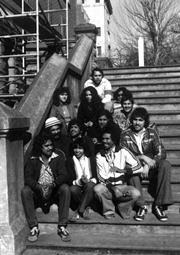09 July 2013
 At the foundation of the University of South Australia in 1990 there was a commitment to Indigenous education written into its charter. Tucked away in section 5.1 c of The University of South Australia Act it states that one of the University’s core functions is to “provide such tertiary education programmes as the University thinks appropriate to meet the needs of the Aboriginal people”.
At the foundation of the University of South Australia in 1990 there was a commitment to Indigenous education written into its charter. Tucked away in section 5.1 c of The University of South Australia Act it states that one of the University’s core functions is to “provide such tertiary education programmes as the University thinks appropriate to meet the needs of the Aboriginal people”.
But that pledge was not plucked from thin air, it followed 18 years of groundbreaking educational outreach to Indigenous Australia through what was known as the Aboriginal Task Force (ATF), a group established at the SA Institute of Technology, which became the proving ground for many of the greatest examples and advocates for the power of education to transform lives.
From July 10 to August 17 the Kerry Packer Civic Gallery will showcase 40 years of achievement in Aboriginal and Torres Strait Islander education in an exhibition entitled The Task Force Story.
The exhibition tells the story in words and candid photographs from the foundation of the task force in the reforming era of Premier Don Dunstan, right through to today.
Professor Stanley Nangala says the impact of the Aboriginal Task Force in the 1970s cannot be underestimated.
“There was a general mood of change and reform but the Task Force was at the epicentre, attracting people from all over Australia to join in a passion and drive for education and for social change,” Prof Nangala says.
“It was the first access point to higher education for Indigenous students who lacked essential prerequisites for entry and it was a program that was actively seeking to engage, inspire and encourage Indigenous students.”
The Task Force was to evolve into the School of Aboriginal and Islander Administration, under the leadership of Prof Colin Bourke and then as the first Faculty of Aboriginal and Torres Strait Islander Studies in any university in Australia.
The David Unaipon College of Indigenous Education and Research at UniSA was established soon afterwards with the goal to encourage excellence in Indigenous scholarship in the tertiary sector.
Identities associated with the ATF include Prof Mary Ann Bin-Sallik, the first Aboriginal coordinator of the ATF and first Aboriginal person to graduate from Harvard with a Masters degree in education, Prof Peter Buckskin, career educator and UniSA Dean of Indigenous Scholarship, Engagement and Research, and Professor Lowitja O’Donoghue who was a member of the advisory committee in the early years of the ATF and after a career in health and administration was named Australian of the Year in 1984 and awarded an AC in 1999.
Others featured in the exhibition include Dr Gary Foley, founder of the Tent Embassy in Canberra in 1972; Bunna Lawrie founding member of the band, Coloured Stone; stage producer, Stephen Albert; Rosemary Burdon-Ingolby, the ATF’s first librarian, and many more.
The exhibition is to be officially launched by SA Minister for Aboriginal Affairs and Reconciliation, Ian Hunter and will be open weekdays at UniSA’s Hawke Building, North Terrace, Kerry Packer Civic Gallery.
Media contact: Michèle Nardelli office: 08 8302 0966 mobile: 0418 823 673 email: Michele.nardelli@unisa.edu.au



